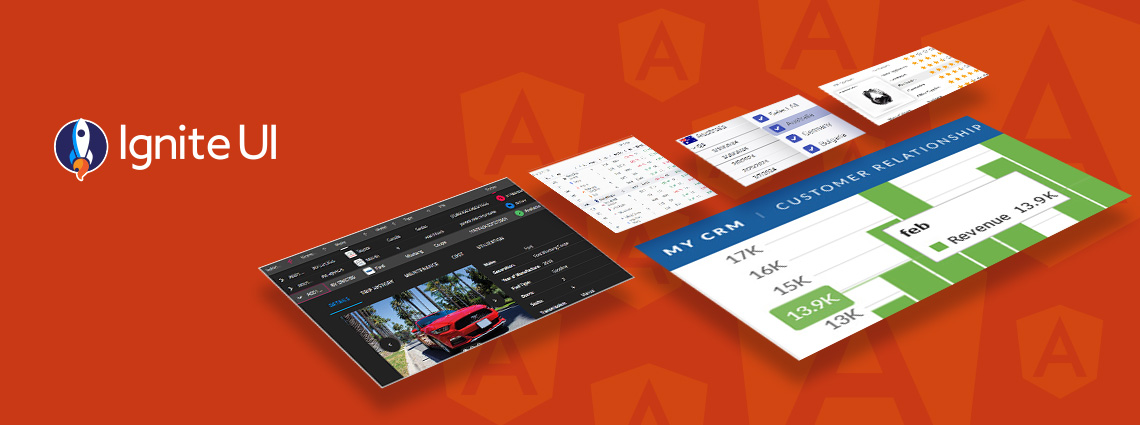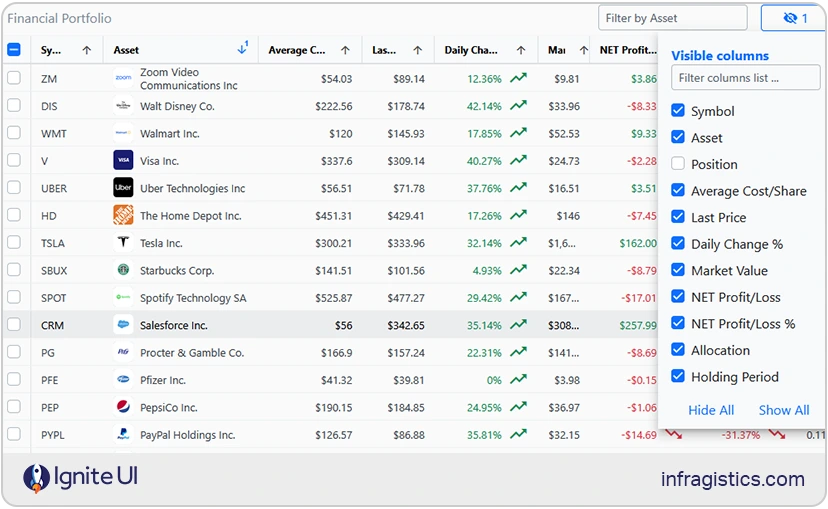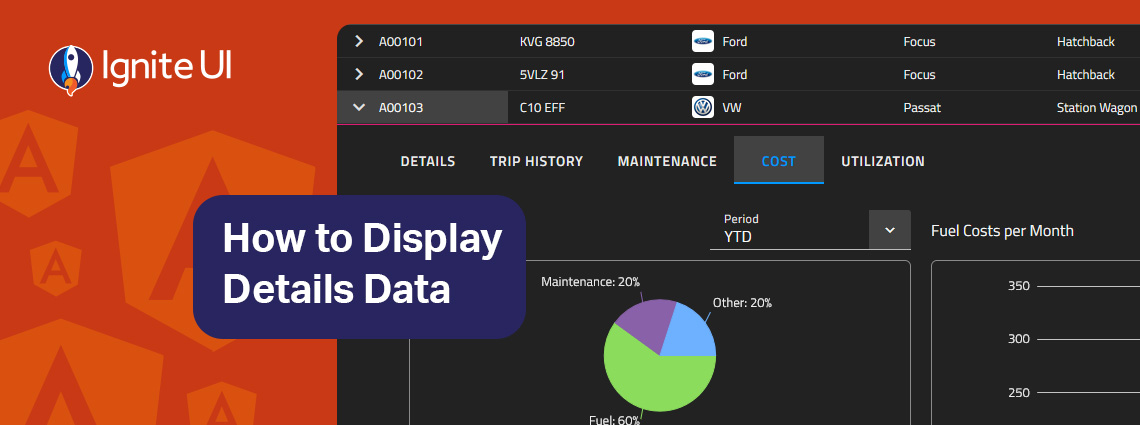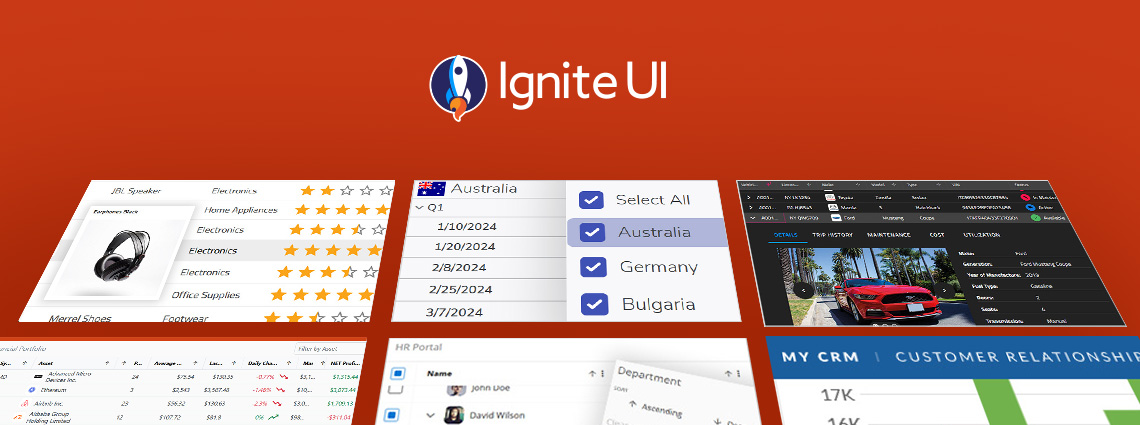
8 AG Grid Alternatives for Your Angular, React, and Web Components Apps
AG Grid is one of the most popular and feature-rich JavaScript Data Grids available today. But are there any AG grid alternatives? Yes. Explore them here.
Is AG Grid still the best choice for building complex data tables in modern web apps? As one of the most well-known and feature-rich JavaScript Data Grids, AG Grid has long been a go-to solution for developers working with Angular, React, and other popular frameworks. However, as the front-end ecosystem continues to evolve, many teams are beginning to explore other more efficient, cost-effective, and flexible options for their specific use case.
However, with a growing number of libraries available on the market today, each offering its own strengths and trade-offs, selecting the right grid could be challenging. Since it can significantly impact both the developer experience and app performance, this article will explore some of the top contenders to make your choice easier. These will include AG Grid and emerging AG Grid alternatives. The blog post will also outline what each one is best suited for, along with any limitations you should consider.
Let’s get started.
| Grid Solution | Best For | Key Features | Advantages | Framework Support | Limitations |
|---|---|---|---|---|---|
| Handsontable | Spreadsheet-like apps, financial/scientific/data-heavy UIs | Sorting, Filtering, Auto Fill, Data Binding, Resizing Rows & Columns, Column Summary, Data Validation | Plugin support, developer-friendly API, easy customization | React, Angular, Vue | Performance issues, limited documentation, heavy for simple use |
| Ignite UI | Full-featured, enterprise-grade applications, data-heavy scenarios | Batch Editing, Advanced Filtering, State Persistence, Virtualization, Keyboard Navigation, and others | Built for speed, functionality and high-performance, Fast grid engine, deep customization, charts, cross-framework support + a separate Pivot Grid control | All modern frameworks | Commercial license required for full access after the free trial expires |
| MUI X Data Grid | Material UI projects, mid-sized React apps | Column Virtualization, Tree Data, Pivoting, Row Reordering, AI Assistant, Quick Filter | Integrates with Material UI, open-core model, intuitive for React developers | React | React-only, advanced features gated behind paid tiers |
| Kendo UI | Enterprise apps | Grouping, Export, Hierarchy, Sticky Columns, Virtualization, Sorting, Accessibility | Strong component suite, polished UI, enterprise-focused | Angular, React, Vue, jQuery | Steep learning curve, commercial license, large bundle size |
| DevExtreme | Enterprise grids, high-performance web apps | Master-Detail, Virtual Scrolling, Export, Live Updates, Filtering, Paging, Record Grouping | Flexible toolkit, responsive design, well-documented | Angular, React, Vue, jQuery | License costs, heavy for basic use, complex styling |
| Syncfusion | Mobile-first, data-rich enterprise apps | Sorting, Filtering, Editing, Selection modes, Column customizations, Data summaries, Exporting | Fast data loading, extensive data visualization options | Angular, React, Vue, Blazor, and more | Commercial license needed, outdated UI in parts, aggressive sales approach |
| ApexCharts Grid | Simple table needs with charts | Sorting, Filtering, Paging, Row-Level Virtualization, Column Resizing, Auto Column Types | Lightweight, open-source, easy integration | All JS frameworks | Limited features, not suitable for large apps, smaller community |
| App Builder | Low-code rapid development, automation, GenAI | WYSIWYG drag-and-drop, CRUD, Real-Time API Binding, GenAI, Code Generation, Swagger | Code generation, Figma-to-code, visual UI, speeds up development by 80% | Angular, React, Web Components, Blazor | Requires license post-trial, limited to selected frameworks |
The Best AG Grid Alternatives: Overview
There are other solutions that break new ground, delivering a lot more in terms of tailored features, seamless integrations, and cost-effectiveness. So, what exactly are the AG Grid alternatives out there?

Handsontable
This one is a popular JavaScript Data Grid that combines a Spreadsheet UI. People generally use it for its ability to handle large volumes of data, but reviews on Reddit indicate it shows some performance issues and lacks extensive documentation.
What Are the Advantages?
- Easy to use, customize, and extend with custom plugins.
- Works with React, Angular, and Vue.
- Excel-like experience when working with it and features like Sorting, Filtering, Auto Fill, Data Binding, Resizing Rows & Columns, Column Summary, Data Validation, and others.
- A developer-friendly API.
- Provides useful tutorials and has community + commercial support.
What Are the Limitations?
- Reported performance issues.
- No extensive documentation.
- Heavyweight for simple tables.
Best for: Excel-like, spreadsheet-focused applications, financial, scientific, or data-heavy grid interfaces, use cases requiring real-time editing and formulas.
Ignite UI
The Ignite UI Grid is built for data-rich apps and is designed to handle millions of records and real-time updates without any performance issues. This makes it one of the top choices among other AG Grid alternatives.

What Are the Benefits?
- Super-fast grid engine that can handle unlimited rows and columns of data instantly.
- Access to custom templates and real-time data updates.
- Advanced Data Grid feature-set for any scenario, such as Batch Editing, Advanced Filtering, State Persistence, Virtualization, Keyboard Navigation, and others.
- Intuitive API for the easiest theming and branding.
- Data binding with minimal hand-coding.
- High-performing charts that can render millions of data points without interruptions.
- Seamless integration with all frameworks.
- A seamless switch between Angular, Blazor, Web Components, or React.
- Mobile-first design, versatility, and ultimate performance on any modern browser.
- Ability to be more agile to changing requirements in a given framework.
- Tons of customization options and unmatched load time.
- Fast and interactive 60+ charts and graphs.
- A vibrant community and support.
- A separate Pivot Grid control.
What Are the Limitations?
- Commercial license required for full access.
- Might be too advanced for simple use cases.
- Learning curve for non-enterprise developers.
Best for: high-performance, data-rich enterprise apps; complex, real-time dashboards in Angular, React, or any other technology; developers needing advanced grid features across frameworks; long-term, reliable support and extensive documentation; grid samples to get you started, etc.
If you want, you can quickly compare Ignite UI for Angular against other vendors to see all the advantages at a glance.
MUI X Data Grid
The MUI X Data Grid is a TypeScript-based component used for displaying data in a structured format of rows and columns. Although popular among developers, it is limited to React.
What Are the Benefits?
- Intuitive API for implementing complex use cases.
- Can handle unlimited sets of data.
- Theming features are designed to be frictionless when integrating with Material UI and other MUI X components.
- It is open-core.
- Packs features such as Inline Editing, Column Grouping, Quick Filter, Column Virtualization, Master-Detail Row Panels, Lazy Loading, Tree Data, Pivoting, AI assistant, Row Reordering, and others.
What Are the Limitations?
- Available only for React.
- The community version is MIT-licensed and free, but more advanced features are locked and require a Pro or Premium commercial license.
Best for: applications already using Material UI; mid-sized React apps needing standard table functionality; developers looking for consistent UI with Material Design, budget-conscious teams (free for small businesses and individuals).
Kendo UI
The Kendo UI JavaScript Data Grid is a top choice among developers, and the reason for this is the number of basic and advanced grid features, plus the promise of high performance.
What Are the Advantages?
- Feature-rich with functionality like Editing, Filtering, Grouping, Export, Virtualization, Sorting, Sticky Rows and Columns, Hierarchy, and more.
- Large suite of additional UI components.
- Strong support for accessibility and globalization.
- High-performing grids.
- Comprehensive documentation and a strong development community.
What Are the Limitations?
- Complex to use with a steep learning curve.
- Commercial license required for full access.
- Bundle size can be large depending on usage.
- Custom styling may require additional effort and experience.
Best for: more experienced developers who are eager to overcome the learning curve; enterprise applications needing polished, out-of-the-box UI; teams using Telerik’s ecosystem for consistency; cross-framework development (Angular, React, Vue, jQuery)
DevExtreme
Known for the responsive grids and speed, DevExtreme provides most of the features that 99% of developers will need. There is a powerful and flexible toolkit to build high-performance, feature-rich web applications across multiple frameworks, including Angular, React, Vue, and jQuery.
What Are the Advantages?
- Supports advanced scenarios such as Master-Detail, Virtual Scrolling, Live Updates, Export to Excel/PDF, and features like Data Filtering, Paging, Sorting, Record Grouping, and Summary Computations.
- Extensive customization options.
- Good documentation.
What Are the Limitations?
- Licensing costs for full features.
- May feel heavier for minimal use cases.
- Styling and theme customization can be complex.
Best for: enterprise-grade data management interfaces;
Syncfusion
Syncfusion offers a comprehensive JavaScript Data Grid that’s part of a larger suite of UI components designed for enterprise-grade applications. Known for its ability to handle large volumes of data efficiently, Syncfusion stands out with its strong performance, extensive feature set, and support across multiple modern frameworks.
What Are the Advantages?
- Can load large amounts of data fast.
- With a mobile-first design that adapts to any resolution.
- Available for Angular, React, Vue, Blazor, and more.
- Flexible editing and record selection modes.
- Various column customizations and data summaries.
- Data exporting options such as PDF, CSV, and Excel.
What Are the Limitations?
- Commercial license needed for full team/commercial use.
- UI styling may not be as modern as Material or custom libraries.
- Slightly steeper learning curve due to the array of features and customizations.
- Aggressive salesforce.
- A free license that could be very limited in terms of features and dev capabilities.
- Localization requires additional effort and time to get it to work properly.
- Version-locked keys.
Best for: developers needing a full suite of controls with strong data visualization, and enterprise apps with heavy customization needs.
ApexCharts
ApexCharts is a popular open-source charting library that helps developers create beautiful and interactive
We are listing this among the top AG Grid alternatives as it is a free JavaScript data grid with all the core features that developers need.
What Are the Advantages?
- Column types that are automatically generated based on the data source, and more.
- It has well-written documentation.
- The Grid is lightweight and provides core features like Sorting, Filtering, Paging, Row-Level Virtualization, Column Resizing, Automatic Column Types, and others.
- It can be easily integrated, designed to work in any framework, on any platform.
- Free and open-source usage.
What Are the Limitations?
- The feature set is not as extensive as in other Grids.
- Still maturing with fewer community resources.
- Not the optimal choice for large-scale, complex applications.
Best for: lightweight projects needing basic table functionality, developers already using ApexCharts for visualization.
App Builder™
App Builder is a low-code tool that has Grid components, which may serve as yet another AG Grid alternative, offering various advantages in terms of speed, simplicity, functionality, and customization.
What Are the Benefits?
- Code generation and preview for Angular, React, Web Components, and Blazor.
- Designed to accelerate application development by abstracting away much of the error-prone manual coding.
- Has visual development interfaces and pre-built, framework-agnostic UI components, reducing development time by 80%.
- GenAI functionality for data source, image, and views generation.
- Focuses on simplicity and user-friendliness so developers with varying levels of expertise can leverage the power of App Builder.
- With out-of-the-box grid functionalities and the most in-demand features, including data visualization components.
- Simplicity is key when configuring a data Grid with all the necessary UX features for customers.
- With Open API (Swagger support) and full Grid CRUD actions (Create, Read, Update, and Delete).
- Real-time Web API updates and code generation in a click.
- Super easy to build apps from scratch, start with sample applications, or convert Figma designs to code.
- Free trial.
What Are the Limitations?
- It requires a license after the free trial expires.
- Limited to Angular, React, Web Components, and Blazor.
Best for: low-code app development, reducing manual coding efforts, enterprise-grade apps, requiring high-performance grids, teams that want to automate repetitive and mundane tasks, use AI + low code for even faster web app creation, citizen developers and programmers with limited know-how.

Summary & Final Thoughts…
As we navigate across the options and various AG Grid alternatives for Angular and React apps available today, it becomes evident that a constant pursuit of innovation and optimization marks the front-end development world. Each alternative to AG Grid tries to address the evolving needs of developers and the diverse nature of projects they undertake, only to deliver better data-driven solutions.
While the number of AG Grid competitors is growing, the decision-making process necessitates an informed approach. That is why critical factors such as source code quality, reliability, ease of use, performance, data grid features, documentation, and community support play pivotal roles in guiding developers toward selecting the most suitable tool for their specific use case.

